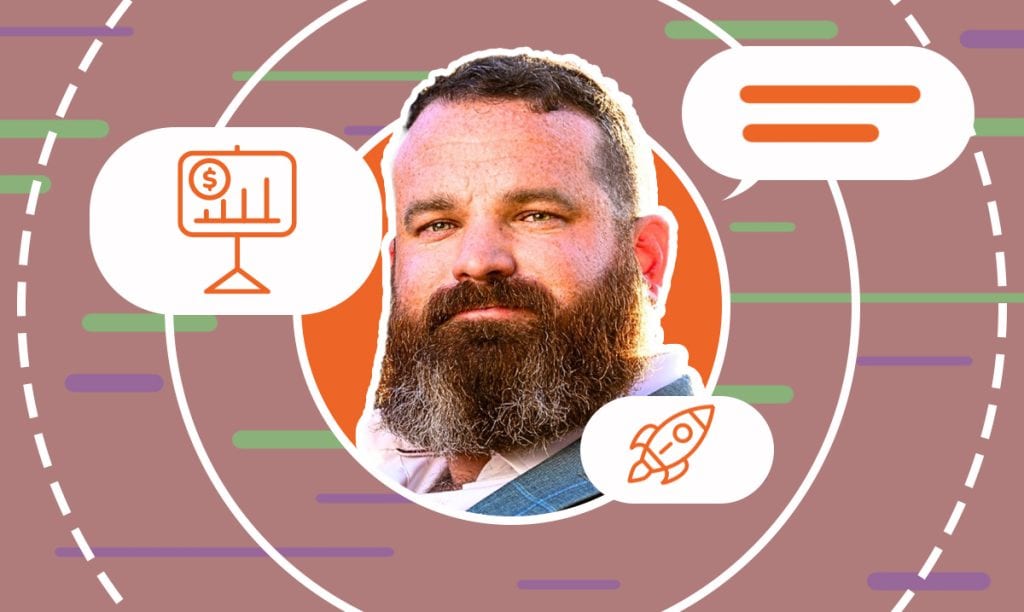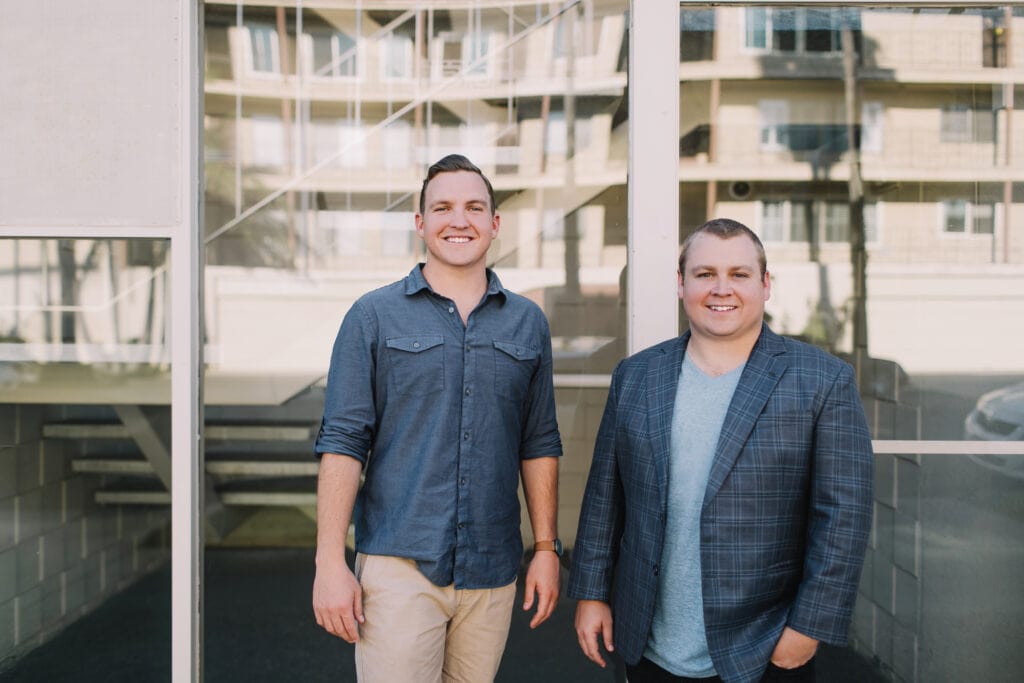Meet Vadim Bozhko, the visionary behind Bozh Studio — a branding and web design business dedicated to helping service-based companies stand out.Fu ...
Robb Fahrion’s Keys to Successful Digital Marketing
Written by: Howard Tillerman
Howard Tillerman is the Chief Marketing Officer for Step By Step Business and an award-winning marketing professional.
Published on March 6, 2024

In this interview, we’re excited to feature Robb Fahrion, the co-founder and partner of Flying V Group, a digital marketing agency. Robb, with his rich experience and innovative approach, has been instrumental in steering Flying V Group to the forefront of digital marketing.
This conversation delves into his unique insights on digital marketing trends, challenges, and strategies that are reshaping the landscape for businesses today. Whether you’re a small business owner or a marketing professional, Robb’s perspectives provide valuable learnings and actionable tips to excel in the digital world.
Tailoring Digital Marketing Strategies Across Industries
SBS – How does Flying V Group tailor digital marketing strategies for diverse industries?
Robb – The differentiation of what we do from client to client is quite vast. We work across different verticals. Even if it is the same vertical, we work with businesses at different lifecycles or stages.
We put the emphasis on the discovery process, diving into that individual business and understanding their pain points, their customer’s pain points, what they’re currently trying to achieve from a goal or KPI standpoint, and then diving deep, asking tons of questions, and trying to put ourselves in the shoes of the CEO or the CMO or whoever it may be that we’re working with.
We take back that information and craft more customized strategies and approaches from there. The blend of products and services is sometimes similar, but we never have the same engagement. There’s no box solution for every client.
As an agency, we are more boutique or white glove. We’re focused on the hands-on approach, being in the trenches with our clients. We recommend a product service fit based on everything we’ve uncovered in that discovery process. That discovery and uncovering all the information we need upfront is one of the most critical points in the engagement. That’s going to dictate what plan of attack we use.
It’s also about understanding the industry as quickly as possible. What I mean by that is we have the discovery process. Once clients say they want to move forward with us, we go deeper. That’s where we continue to gather more information and have conversations, and they can tell us about past experiences. As the campaign moves forward, we also have that constant line of communication. Then, we’re actively promoting, advertising, and marketing, but we want to be in tune with our clients in terms of regular communication and feedback loops. That helps us get up to speed with what they know and helps us see things from their side and point of view.
Ensuring ROI Transparency and Client Understanding
SBS – How do you ensure that a campaign has a good return on investment but still ensure that your clients understand where the cost is going and what the results are?
Robb – It’s twofold. One, you have to set the expectations. Depending on what they want to achieve, many different factors and variables go into the levels of success that we can have. We set those expectations and let them understand there might be a pivot in the approach because we will be more effective based on the budget size. Instead of them going after everything, in a perfect world, we might need to tone that down and be more particular with our targeting and the services we recommend. If we want to build long-term success and staying power, we might recommend working on search engine optimization and content.
The expectation of when the return happens must also be set right. You’re often laying that foundation in that first month, or two, or three months before we start to see any returns. But then there’s that exponential growth curve the further we get out from the commencement of the engagement.
Tracking and analytics are probably more important than setting expectations. What are we doing to ensure that we have accurate tracking in place? Whatever it is that we are tracking is something that leads to some transaction or return action in terms of a sale or a lead generation. Whatever that may be, we emphasize utilizing the different tools. We use advanced tracking mechanisms, installing pixels and firing tags on specific events on the website. That will give us accurate data and information and tell us whether there’s a return. The point is you’re going to be able to make that change a lot quicker vs. if you didn’t have that data and information and you needed to wait on feedback from the client to tell you that things aren’t working. That’s where time is money, and that return gets harder to catch up on.
Success Stories
SBS – Can you share some success stories where some small businesses benefited from your services?
Robb – We’re based in Orange County, California, and work with a local car wash (BLISS Car Wash) with multiple locations. We started with them in January of 2023. They just wanted more volume of cars through their washes at all their locations, so we took a look at the website, analyzed that, took a look at what they were doing from a targeting standpoint with paid advertisement and adjusted their strategy.
They were running a lot of Facebook Meta advertisements, which is fine, but we said we wanted to focus on organic search because the existing competitors’ content and information that’s out there are not strong. There was a lot of low-hanging fruit regarding acquiring traffic we could drive. Also, their site was not set up for localized success from an SEO standpoint. They were driving all their traffic to one page with all their different locations. We made a pretty simple adjustment — we pulled out all those locations into individual pages. Then we started working on optimizing local keywords (for “car wash near me” or whatever the city was). All of a sudden, we were in a much more competitive space.
The other thing we did was related to the nature of their business. You could run a Meta ad, and someone could see it, get in their car, and drive to the wash, which is great. That’s a net positive. The issue was the actual tracking of that. There’s no real way to know that individual came from this ad. So, we do a lot of work with programmatic ads (geotargeting and geofencing). We shifted their ad strategy. We’re still using some Meta ads for retargeting. Still, the programmatic is the heavy lifting on the ads because we can track the device that was served an ad and whether or not it ends up in our geofenced location around the car wash. That’s been fun because we had to get a little bit creative going back to analyzing the situation, understanding the pain points, and then recommending a solution. This is a really clear, albeit simple, example, but the results have been tremendous. This year, I think they’re rolling out six more new locations.
SEO is a tough thing to explain in layman’s terms. It’s also difficult to sell because it is more of a theoretical concept — we’re going to do this, this, and this, and we think it will generate this type of result. We’re confident that it will just based on the amount of engagements we’ve had, how we create new content, and how we structure the website.
Talking with the CEO about the paid media budget and attracting x, y, and z traffic and amounts seems more reassuring in the psychological aspect. They think they’ll get much more certainty from a paid media budget than the SEO budget, but we argue that the long-term exponential return of the organic search efforts is by far the most tremendous. It also creates a moat around your business if you can acquire those top positions because competitors can’t just come in and hijack those.
It’s earned media and earned placement, which is always the best. You hear that a lot in PR. You’re not just paying for a placement. You’re earning that placement because you have something unique and an offer that stands out from the crowd.
Key Metrics for Measuring Campaign Success
SBS – What metrics do you use to measure the success of your campaigns?
Robb – It will be variable based on the advertising effort and where you’re sitting in the organization. For myself, I’m looking at the higher-level executive KPIs. I put a heavy focus on the pillar stuff. If we’re talking about search engine optimization, I’m not immediately focused on traffic. I’m focused on driving higher impression numbers. That’s a leading indicator that we’re starting to move the rankings up, and eventually, that traffic number will come.
Often, people are too focused on the end result KPIs vs. looking at many of those leading indicators. If we’re also talking paid media, I may not be focused immediately on the conversions because the person’s not even on the site when we’re running these ads. Out of the gate, I will focus on the click-through rate. Is our message resonating with the audience that we’re putting this content and information in front of? If it is, and we see that we’re having continual improvements from a click-through rate standpoint, that should also drop our cost per click number so our budget is being expanded and furthered. At that point, I’m confident we’re driving high enough clicks, and my focus shifts to what’s happening when that user is actually on the site. That’s when you will track conversion rate and cost per conversion.
You have a spectrum of conversions. You have micro-conversions, which lead that person to make a buying decision or reach out for more information from your business about whatever services you offer. Consider traffic to the website as a micro conversion and focus on increasing that volume. If you have ebooks or lead magnets on your site, focus on getting people to download those and capture email information because all of those are little positive signals until that person gets to that buying decision.
At the end of the day, as marketers, we can’t necessarily determine the perfect place and time when that person is going to make that buying decision. We can just set up the structure and look at those leading indicators that will tell us we’re moving in the right direction. Then, as you get more advanced, you start to get into deeper or conversion-focused analytics.
Time on site is also a really strong metric that often goes underlooked. The longer we can keep people on our site, the more engagement we get. They’re reading more content information and traveling to more pages, and that’s where they’re educating themselves on the buying process.
Strategies for Small Companies
SBS – What strategies do you use for smaller companies that need to compete with larger ones?
Robb – It’s the mouse and the elephant argument. Again, it comes to the expectations. Suppose you have a small business that also operates in an industry with much larger players. In that case, you need to think about how you can get into areas or nooks and crannies that are tougher for that larger company to get into or for them to have a keen eye on.
Many times, businesses may be able to service the entire United States. Still, I tell them their budget won’t be able to compete with those large organizations that can dump and spend large amounts of money across a wide area, but where we can beat them is more in that hyper-localized and hyper-targeted area. Whether it’s based on locale or a particular demographic, you need to start creating things that are much more personalized. There are two reasons for that.
One, personalized messaging, as we know, works much better. If I’m specifically putting a message for an individual in a particular place or one specific person, the resonation of that goes over a lot better. Not only that, but your actual budget can be competitive at that more granular level. Yeah, your competitors have a large budget spread over a larger area, but your budget is more concentrated on a specific area we are targeting. That’s where that creativity in terms of how you’re going to target and who you’re going to target becomes critical. Otherwise, you’re throwing sand in the wind, and who knows where it goes.
You also need to look at where you can be strategic on your platform and where you can have content that shines through vs. just going from a pay-per-click standpoint. The average cost per click is x, which can be tough to compete if your budget doesn’t match what these big players are bringing to the table.
Creating SEO Content that Resonates
SBS – How do you ensure your content resonates with the target audience and is SEO-optimized?
Robb – For us, it’s keyword research, going into the market, and seeing what people are looking for and how they are looking for it. We’re also going back to competition and looking at the keyword competitiveness. Certain SERPs and keywords are up there, no matter how good your content might be. There’s such a stranglehold from more powerful websites and corporations, or the content has been talked about for so long that those top positions are unmovable.
We’re looking at those gaps. We see volume and competition regarding content relevancy, accuracy, and keyword intent. Transactional keywords are the best from a conversion rate standpoint. They are more top-of-the-funnel vs. keywords that give you informational awareness. You need to consider all those factors when discussing creating content and whether or not it will resonate. It’s important to strategize what it is you’re going to write. That’s the most critical piece.
A lot of times, I see companies don’t even do that at all. They write four blog posts per month based on what they think they should write about. That’s a dangerous game because you’re wasting time. After all, many other companies are doing that same thing, so you’re not putting yourself in a competitive place.
Processes are also important for us. Because we’re doing lots of blog content creation, white papers, and the whole nine yards on the content side, having that process is a must. We’re writing the content that’s validated based on the research.
From there, we go through the editorial process, ensuring the readability is on point, the structure is good, interlinking is there, SEO components are involved, images are added, etc. We use technology that helps us throw our draft up against the results already ranking online. It gives us a nice comparison and shows us if we’re doing a better job providing for the intent of the search.
After that editorial process comes the publication, but it doesn’t end there. Nowadays, with so many channels that are online, the repurposing of content becomes extremely important. Are you sending that content to your email list? Are there little blocks that you can pull out and repurpose on social media?
Can we add a video on each blog highlighting specific components that need to be spoken or get more context?
Then again, we’re back to monitoring if the content moves the needle. Is it ranking, and is that content driving action on the website?

Leveraging Social Media for Small Business Growth
SBS – How do you leverage social media for small businesses?
Robb – Social media is more critical for small businesses because when the users are making a buying decision, they’re also sorting through the companies they can trust and those that are real and have value. Number one, social media is that social proof. Number two, it shows the consistency of a business and the results. Larger corporations might already have that brand authority and trust built in because of their size. They can offer the same things as a smaller business, but when you go to their social media, it may not be as updated as that of a smaller company. That tiny margin often makes all the difference in who an individual chooses to go with.
I always tell small business owners to commit to what they can do. That’s where they get in trouble as well. They feel like they need to post daily on social media, just like their big competitors do. That’s happening at the owner/founder level, and they experience burnout pretty quickly, or it just gets put on the wayside and never happens. It’s happened to me as well, for sure. If you can post once a week, focus on posting once a week, and you’ll get more in tune with it, and it’ll become easier. You’ll come up with processes, and then, eventually, you’ll get that off your plate and have someone else take care of it and accelerate the volume. The biggest thing is setting realistic expectations for what you can do.
Navigating Google Core Updates and the Future of SEO
SBS – What do you say to people who were heavily affected by the latest Google core updates, and how do you see the future of SEO regarding AI and future core updates? What is your suggestion to business owners and marketers?
Robb – This is a very popular topic. Right now, more content is being created than ever in the history of mankind just due to AI evolution and the ease with which you can create new content and material. At the same time, the differentiation between the content is as slight as ever because much of the content is being generated and driven through the same platforms, whether ChatGPT or another platform.
Going back to the core and helpful content updates, I think that’s where Google focuses even more on the brands and the businesses that create unique content. What I mean by that is injecting your own experiences, expert insights, and tips.
I’ll give an example. When writing a blog post, we inject what we experienced at Flying V Group in the middle of it. Because, at the end of the day, it’s humans doing business with humans. If you’re generating through AI without practical experience, that content will fall flat because it could have been created by anyone anywhere, and there’s no uniqueness.
The video component is strong as well. You can create content and add a 30-second or minute-long video highlighting the different points and tips or whatever it may be.
For those creating high-quality content, this is going to be a great opportunity to even further differentiate themselves when everybody else is trying to do things with quick, easy wins.
We haven’t had a Google Core update for a prolonged period. Still, we know something’s coming, and we need to make sure we’re differentiating the companies and the businesses that are doing it right and creating content that shows their expertise and the ability to do whatever they say online.
I think the bar set for the quality of content will continuously move up to where you’re not just going to be able to pump out large volumes of very generic, bland content without doing some additional support effort on top of it. It’ll be interesting. That’s a hypothesis of mine. We’ll see how it all shakes out. But for us, it always goes back to providing high-quality content and information based on experience and understanding. If you keep that in mind when creating that content, you’re going to be okay regardless of the ebbs and flows of the algorithm updates because those will happen regardless.
We cover a lot of different service lanes. For that exact reason, you have to have a holistic, omnichannel, diverse approach to marketing and advertising at this point, not only because different channels can support one another and drive down those cost per acquisition numbers, but It also makes you more secure from a risk standpoint. You might lose a bit because of the Google algorithm update, but you still have channels supporting and lifting your business.
Subscribe to Our Newsletter
and gain insider access to cutting-edge business insights and trends.
Featured Resources

How “Less but Better” Drives Bozh Studio’s Design Edge
Published on April 3, 2025
Read Now

How No Code Map App Delivers Custom Maps Without Coding
Published on April 3, 2025
In this interview, we sit down with Nan Zhou, co-founder of No Code Map App, to discuss how she and her team transformed a trip-planning mapinterfac ...
Read Now

How David Pere Helps Veterans Achieve Financial Freedom
Published on April 3, 2025
In this interview, David Pere, the founder of From Military to Millionaire, shares his inspiring journey from the Marine Corps to financial freedomt ...
Read Now

Comments